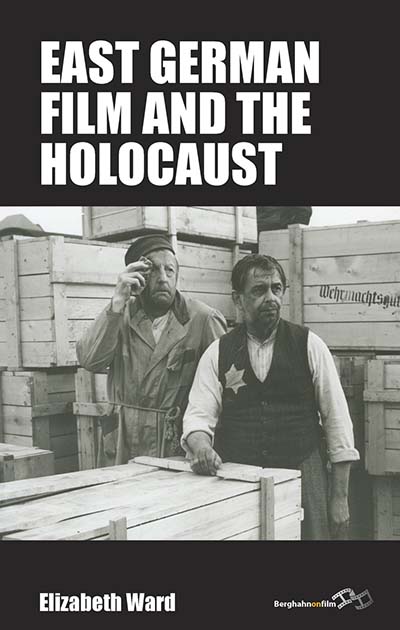

This is part of our special feature on European Culture and the Moving Image.
Despite the Allies’ efforts for denazification and reeducation, East and West Germany have both been haunted by the shadow of their Nazi past and it has often been assumed that denial and silence prevailed in the early post-war years. What is less known perhaps is that German-born filmmakers (including Jewish directors and rémigrés) were repeatedly denied a license to make films, especially in the Western sectors of divided Germany. The reason for the one-year long break from filmmaking in these sectors was that the Allies sought to dismantle the Nazi centralized film industry. Such challenges notwithstanding, the very first postwar film made on German soil—in the Soviet zone of occupation—Wolfgang Staudte’s 1946 The Murderers Are Among Us―broaches the uneasy subject of Jewish persecution by following a survivor upon return from the camps at a time when the full extent of the genocide was yet unknown. Through subversive visual references to such antisemitic and racist propaganda pictures as Fritz Hippler’s infamous 1940 The Eternal Jew, Staudte’s film confronted antisemitism that continued well after May 1945.
Founded in the Soviet sector shortly after Staudte’s film premiered, the film studio DEFA (Deutsche Film-Aktiengesellschaft, 1946-1992) continued to release films about the Holocaust. Numerous scholars since 1990 have scrutinized the relationship between the company and the “antifascist state” or “the first socialist state on German soil,” as the German Democratic Republic (GDR) was rendered in late-1940s foundational narratives. Until the early 2000s, however, English-language publications tended to see DEFA in isolation from other Central and Eastern European cinemas, as well as largely emancipated from the free-market economy that governed filmmaking in Germany before and after WWII. This approach, however, has gone awry because it produced a stubborn oblivion of crucial historical continuities, such as the one between the state-run studio and its well-known precursor—and one of the largest European studios—UFA (Universum Film Aktiengesellschaft, 1917-1945). As well-known, under the Nazi propaganda minister Joseph Goebbels’ auspices, UFA produced many openly or subtly antisemitic features—among them, sophisticated melodramas, distracting comedies, and couth costume dramas.[1] Like UFA, DEFA, too, sought to garner international prestige and to ensure distribution of its films abroad. In the last three decades, as East German films were rediscovered by international audiences and entered the classroom, some lacunas in scholarship were filled and DEFA’s transnational position reexamined.[2] Nevertheless, a few sore questions about the relationship of the socialist state, the shared German past, and postwar German cinema remained open. In particular, the role of DEFA pictures in the process of remembering and reworking the Nazi past—both in the GDR and the Eastern bloc―drew some attention, especially in the ways in which they touched on taboo topics and challenged or conformed to dominant official commemorative discourses.
Elizabeth Ward’s exceptionally researched monograph, East German Film and the Holocaust bravely addresses such questions, eloquently marrying a historiographic approach with a close film analysis to shed light onto interwoven production and reception histories; and ultimately- onto how and why DEFA films engaged with the Holocaust. To that end, she introduces several levels of inquiry that together form a holistic and nuanced representation of the ways in which the Holocaust was rendered and remembered on the silver screen and on TV; and, in the process, rightly contests the term “Holocaust film” as not sufficiently defined or unambiguous (8). Instead of grappling with the blurry boundaries of Holocaust cinema, films to be discussed are selected according to two criteria: the stories must be set within the time frame 1933-1945, and Jewish victimhood or persecution has to be central to the plot. In applying these selective criteria, Ward foregrounds DEFA pictures that have too often been folded within a larger cannon of the so-called “antifascist” cinema, yet never fully appreciated for what they were- stories of Jewish life, suffering, perseverance, and survival.
East German Film and the Holocaust follows closely the freezes and thaws within the socialist bloc to offer a much-needed insight into the vagaries of commemoration, production, censorship, and reception of nine exponent films about the Holocaust. Central to this endeavor is how East German filmmakers represented on screen Jewish persecution, suffering, and genocide in the context of a state rhetoric that foregrounded antifascist resistance and communist victimization. By tackling this question, Ward also engages with UFA’s heritage, especially in the early chapters, where she reconsiders the way melodrama was appropriated by established directors, such as Kurt Maetzig and Konrad Wolf, who had Jewish parents, lost family members in the camps, and experienced firsthand persecution by the Nazi regime.But Ward does not thematize the religion, political orientation, or national identities of the directors who made East German films about the Holocaust. Rather, she elucidates Jewish agency and positionality and the politics of representation. Though a number of DEFA films treated the Holocaust as a relatable entity and, therefore, aimed to educate viewers about antifascism, others kept audiences at a distance, in the position of “onlookers,” rendering unintelligible the suffering that victims and survivors experienced. At the same time, the onlooker position channeled the denial that existed in the GDR about atrocities committed by common (East) Germans during the Third Reich and perpetuated the popular belief that most Nazis lived in the capitalist West Germany.
While scholars such as Frank Stern, Detlef Kannapin, and Anke Pinkert have discussed DEFA films about the Holocaust within the paradigm of the antifascist genre, Ward convincingly demonstrates that East German pictures about Jewish persecution, victimhood, and annihilation deserve attention on their own, especially if we want to understand how and why “the Holocaust was a present and permissible theme in East German cinema” (3).[3] The picture is quite complicated, as Ward contends: on the one hand, the GDR state cashed economically and politically from the release of these films, as in the case of Jakob the Liar (1974, dir. Frank Beyer)―the first DEFA picture nominated for an Academy Award (153) where an antifascist character is largely absent from the plot. On the other hand, import of Western-made productions about the Holocaust was often sanctioned, thus revealing the stark control over the past and over commemorative practices that the state retained. Here is where the question of representation—both on the narrative and visual level—becomes crucial. Therefore, to shed light on the intricate and shifting relationship between film and the Holocaust in East Germany, Ward scrutinizes the aesthetic and narrative strategies that DEFA filmmakers employed in order to interact with the memory and the commemoration of Jewish persecution and murder, as well as to attend to the GDR politicization of the past.
Numerous discussions blend Central and Eastern European pictures of various genres, such as war and childhood dramas or biopics, but merely mention in passing the history of the Holocaust to solely supplement anti-fascist narratives. What sets Ward’s monograph apart is her analysis of “the discord between content and context” (7) in DEFA films by making the confrontation between narratives and visual strategies central to the nine films she selected for review. The book paints a new picture of DEFA films about the Holocaust and questions why the latter was a recurrent theme in East German cinema—even when a film’s focus was exclusively on Jewish characters and excluded strong antifascist or “positive” (in the sense of socialist realism) heroes. To explain the reasons for the repeated engagement with the Holocaust and Jewish persecution in East German cinema, Ward devotes close attention to three aspects of representation. First, she highlights the codification of Jewish positionality and identities on celluloid, which as the book shows, continued to change throughout the decades. Second, Ward exposes the outright uncritical and thus highly problematic depiction of the perpetrator on screen, as the audience often remains in a passive, observing position. Last, but not least, the author reveals the unexpected lucrative marketing of DEFA films about the Holocaust in the West, where ideological aspects were concomitantly downplayed in favor of attracting international attention (for the desired diplomatic recognition) and economic profit for the GDR government.
Ward analyzes an impressive array of films, documenting their production and reception at home and abroad–from DEFA classics, such as Kurt Maetzig’s 1947 Marriage in the Shadows and Konrad Wolf’s 1959 Stars to less-known pictures, such as Living Ware (1966, dir. Wolfgang Luderer) and Stielke, Heinz, Fifteen (1986, dir. Michael Kann) to TV productions, such as The Pictures of Witness Schattmann (1972, dir. Kurt Jung-Ahlsen). Her findings are perhaps most indicative for the ongoing debates about the extent to which the Holocaust was ignored or acknowledged in the GDR (both by its government and population). This premise of the ignorance vis-à-vis the Nazi past continues to shape discussions in Europe today about the largely present denial of responsibility for the post-1990 surge in antisemitic actions and views in the former East German federal states. Importantly, in East German Film and the Holocaust, Ward shows that while it is true that the socialist state did relocate the shared responsibility for the atrocities of the Third Reich to its capitalist counterpart, West Germany, the Holocaust still played—albeit not a central—role in East German private and political discourses about the past. “East German Holocaust films,” Ward explains, “repeatedly created an alternative space for discussions not only of Holocaust memory in the GDR, but also of the cornerstones of intergenerational national identity in the past and present” (13).
With such illuminating insights, Ward provides key correctives to dominant narratives in (East) German film historiography. Films, such as Jakob the Liar or Siegfried Kühn’s 1988 The Actress, are cast in new light via production documents and press voices—many of which find their way into an English-language publication for the first time. The monograph’s extensive filmography—also the first of its kind in English—and the archival materials including press and print reviews that Ward consulted make this book an important resource for scholars and teachers of East German cinema like myself. Equally important to scholars of East German film and Holocaust studies is Ward’s ability to foreground subtle yet crucial details in her film analyses and weave them together with insights from interviews, private and company correspondence, political officials’ statements, and industrial papers. She thus invites a timely and long-overdue reflection on the DEFA films’ overt and covert representations of complicity, atrocities, displacement of responsibility, and silence, as well as on the need to remember. Indeed, Ward achieves her goal that “has not been to replace one singular narrative with another, but conversely to complicate our understanding of presentations of Jewish persecutions in the GDR” (221).
Mariana Ivanova is the Academic Director of the DEFA Film Library and Associate Professor of German Film and Media at the University of Massachusetts Amherst. Her 2019 book, Cinema of Collaboration: DEFA Coproductions and International Exchange in Cold War Europe approaches the Cold War division through the lens of film coproductions and exchange, artistic collaboration, and cultural mediation, and responds to the need to rethink socialist cinemas within the evolving discursive space of European filmmaking. Ivanova has also published and given talks on the ways the GDR is represented and “remembered” in film, on genre and censorship practices within socialist cinematic industries, and on transborder movement for the purposes of producing and distributing films.
East German Film and the Holocaust
By Elizabeth Ward
Publisher: Berghahn Books
Hardcover/ 245 pages/ 2021
ISBN: 978-1-78920-747-7
References
[1] Eric Rentschler, The Ministry of Illusion: Nazi Cinema and Its Afterlife (Cambridge, MA: Harvard University Press, 1996); Valerie Weinstein, Antisemitism in Film Comedy in Nazi Germany (Bloomington, IN: Indiana University Press, 2019).
[2] Marc Silberman and Henning Wrage, eds. DEFA at the Crossroads of East German and International Film Culture (Berlin, Boston: De Gruyter, 2014); Seán Allan and Sebastian Heiduschke, eds. Re-Imagining DEFA: East German Cinema and Its National and Transnational Contexts (New York, Oxford: Berghahn, 2016).
[3] Barbara Eichinger, Frank Stern, eds. Film im Sozialismus: die DEFA (Vienna: Mandelbaum, 2009); Detlef Kannapin, Antifaschismus im Film der DDR: DEFA Spielfilme 1945-1955/56 (Cologne: PapyRossa, 1997); Anke Pinkert, Film and Memory in East Germany (Bloomington, IN: Indiana University Press, 2008).




